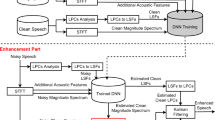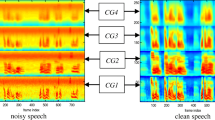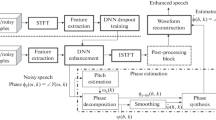Abstract
In contrast to the adverse environments, performances of existing speech enhancement algorithms do not always produce satisfactory results. In the case of worst signal to noise ratio, the processing is complicated and it may introduce signal distortions and degradation of intelligibility. To overcome the complexity of the existing speech enhancement algorithms, a hybrid concept for enhancing the speech quality and intelligibility is proposed in this research. The primary objectives of the research work is to increase the intelligibility of the speech enhancement system that has been trained for a particular speech signal using modified deep neural network (DNN) and adaptive multi-band spectral subtraction (AdMBSS). In this work, AdMBSS is used for enhancing the intelligibility of the speech signal using the additional phase information calculation, and finally, hybrid DNN and Nelder Mead optimization is utilized to improve the signal quality. Experimental results explain that the proposed framework achieves improved performance in signal to noise ratio, perceptual evaluation of signal quality and minimum mean square error. Finally, performances are taken for the more noises like bus noise, train noise, babble noise, airport noise, station noise and exhibition noise.






Similar content being viewed by others
References
Hu, Y., & Loizou, P. C. (2007). Subjective comparison and evaluation of speech enhancement algorithms. Speech Communication,49(7), 588–601.
Loizou, P. (2017). NOIZEUS: A noisy speech corpus for evaluation of speech enhancement algorithms. Speech Communication, 49, 588–601.
Hu, Y., & Loizou, P. C. (2008). Evaluation of objective quality measures for speech enhancement. IEEE Transactions on Audio, Speech and Language Processing,16(1), 229–238.
Martin, R. (2005). Speech enhancement based on minimum mean-square error estimation and supergaussian priors. IEEE Transactions on Speech and Audio Processing,13(5), 845–856.
Lotter, T., & Vary, P. (2005). Speech enhancement by MAP spectral amplitude estimation using a super-Gaussian speech model. EURASIP Journal on Applied Signal Processing,2005, 1110–1126.
Loizou, P. C. (2005). Speech enhancement based on perceptually motivated Bayesian estimators of the magnitude spectrum. IEEE Transactions on Speech and Audio Processing,13(5), 857–869.
Loizou, P. C., & Kim, G. (2011). Reasons why current speech-enhancement algorithms do not improve speech intelligibility and) suggested solutions. IEEE Transactions on Audio, Speech and Language Processing,19(1), 47–56.
Cohen, I. (2005). Relaxed statistical model for speech enhancement and a priori SNR estimation. IEEE Transactions on Speech and Audio Processing,13(5), 870–881.
Ghanbari, Y., & Karami-Mollaei, M. R. (2006). A new approach for speech enhancement based on the adaptive thresholding of the wavelet packets. Speech Communication,48(8), 927–940.
Mohammadiha, N., Smaragdis, P., & Leijon, A. (2013). Supervised and unsupervised speech enhancement using nonnegative matrix factorization. IEEE Transactions on Audio, Speech and Language Processing,21(10), 2140–2151.
Cohen, I. (2005). Speech enhancement using super-Gaussian speech models and noncausal a priori SNR estimation. Speech Communication,47(3), 336–350.
Skowronski, M. D., & Harris, J. G. (2006). Applied principles of clear and Lombard speech for automated intelligibility enhancement in noisy environments. Speech Communication,48(5), 549–558.
Taal, C. H., Hendriks, R. C., Heusdens, R., & Jensen, J. (2011). An algorithm for intelligibility prediction of time–frequency weighted noisy speech. IEEE Transactions on Audio, Speech and Language Processing,19(7), 2125–2136.
Shao, Y., & Chang, C.-H. (2007). A generalized time–frequency subtraction method for robust speech enhancement based on wavelet filter banks modeling of the human auditory system. IEEE Transactions on Systems, Man, and Cybernetics, Part B (Cybernetics),37(4), 877–889.
Lu, Y., & Cooke, M. (2009). The contribution of changes in F0 and spectral tilt to increased intelligibility of speech produced in noise. Speech Communication,51(12), 1253–1262.
Hansen, J. H., Radhakrishnan, V., & Arehart, K. H. (2006). Speech enhancement based on generalized minimum mean square error estimators and masking properties of the auditory system. IEEE Transactions on Audio, Speech and Language Processing,14(6), 2049–2063.
Taghia, J., & Martin, R. (2014). Objective intelligibility measures based on mutual information for speech subjected to speech enhancement processing. IEEE/ACM Transactions on Audio, Speech and Language Processing (TASLP),22(1), 6–16.
Xu, Y., Du, J., Dai, L.-R., & Lee, C.-H. (2015). A regression approach to speech enhancement based on deep neural networks. IEEE/ACM Transactions on Audio, Speech and Language Processing (TASLP),23(1), 7–19.
Kim, G., & Loizou, P. C. (2010). Improving speech intelligibility in noise using environment-optimized algorithms. IEEE Transactions on Audio, Speech and Language Processing,18(8), 2080–2090.
Jokinen, E., Takanen, M., Vainio, M., & Alku, P. (2014). An adaptive post-filtering method producing an artificial Lombard-like effect for intelligibility enhancement of narrowband telephone speech. Computer Speech & Language,28(2), 619–628.
Petkov, P. N., Henter, G. E., & Kleijn, W. B. (2013). Maximizing phoneme recognition accuracy for enhanced speech intelligibility in noise. IEEE Transactions on Audio, Speech and Language Processing,21(5), 1035–1045.
Tsao, Yu., & Lai, Y.-H. (2016). Generalized maximum a posteriori spectral amplitude estimation for speech enhancement. Speech Communication,76, 112–126.
Chen, F. (2016). Predicting the intelligibility of noise-corrupted speech non-intrusively by across-band envelope correlation. Biomedical Signal Processing and Control,24, 109–113.
Zorilă, T.-C., Stylianou, Y., Ishihara, T., & Akamine, M. (2016). Near and far field speech-in-noise intelligibility improvements based on a time–frequency energy reallocation approach. IEEE/ACM Transactions on Audio, Speech, and Language Processing,24(10), 1808–1818.
Goehring, T., Bolner, F., Monaghan, J. J. M., Dijk, B. V., Zarowski, A., & Bleeck, S. (2017). Speech enhancement based on neural networks improves speech intelligibility in noise for cochlear implant users. Hearing Research,344, 183–194.
Kolbæk, M., Tan, Z.-H., & Jensen, J. (2017). Speech intelligibility potential of general and specialized deep neural network based speech enhancement systems. IEEE/ACM Transactions on Audio, Speech, and Language Processing,25(1), 153–167.
Loizou, P. C. (2013). Speech enhancement: Theory and practice. New York: CRC Press.
Samui, S., Chakrabarti, I., & Ghosh, S. K. (2016). Improved single channel phase-aware speech enhancement technique for low signal-to-noise ratio signal. IET Signal Processing,10(6), 641–650.
Ozaki, Y., Yano, M., & Onishi, M. (2017). Effective hyperparameter optimization using Nelder-Mead method in deep learning. IPSJ Transactions on Computer Vision and Applications, 9, 20.
Hori, T., Chen, Z., Erdogan, H., Hershey, J. R., Roux, J. L., Mitra, V., et al. (2017). Multi-microphone speech recognition integrating beamforming, robust feature extraction, and advanced DNN/RNN backend. Berlin: Springer.
An efficient MFCC extraction method in speech recognition
Xu, Y., Du, J., Dai, L.-R., & Lee, C.-H. (2014). Global variance equalization for improving deep neural network based speech enhancement. In IEEE China summit & international conference on signal and information processing (China SIP), 2014 (pp. 71–75). IEEE.
Zue, V., Seneff, S., & Glass, J. (1990). Speech database development at MIT: Timit and beyond. Speech Communication, 9(4), 351–356.
Kavalekalam, S. M., Christensen, M. G., Gran, F., & Boldt, J. B. (2016). Kalman filter for speech enhancement in cocktail party scenarios using a codebook-based approach. In IEEE international conference on acoustics, speech and signal processing (ICASSP), 2016 (pp. 191–195). IEEE.
Kirubagari, B., Palanivel, S., & Subathra, N. (2014). Speech enhancement using minimum mean square error filter and spectral subtraction filter. In International conference on information communication and embedded systems (ICICES), 2014 (pp. 1–7). IEEE.
Hu, Y., & Loizou, P. C. (2003). A generalized subspace approach for enhancing speech corrupted by colored noise. IEEE Transactions on Speech and Audio Processing, 11(4), 334–341.
Ephraim, Y., & Malah, D. (1985). Speech enhancement using a minimum mean-square error log-spectral amplitude estimator. IEEE Transactions on Acoustics, Speech, and Signal Processing, 33(2), 443–445.
Liu, B., Tao, J., Wen, Z., & Mo, F. (2016). Speech enhancement based on analysis-synthesis framework with improved parameter domain enhancement. Journal of Signal Processing Systems,82(2), 141–150.
Hirsch, H. G., & Pearce, D. (2000). The Aurora experimental framework for the performance evaluation of speech recognition systems under noisy conditions. In ASR2000-automatic speech recognition: Challenges for the new Millenium ISCA tutorial and research workshop (ITRW).
Rix, A. W., Beerends, J. G., Hollier, M. P., & Hekstra, A. P. (2001). Perceptual evaluation of speech quality (PESQ)-a new method for speech quality assessment of telephone networks and codecs. In 2001 IEEE international conference on acoustics, speech, and signal processing. Proceedings (Cat. No. 01CH37221) (Vol. 2, pp. 749–752).
Author information
Authors and Affiliations
Corresponding author
Additional information
Publisher's Note
Springer Nature remains neutral with regard to jurisdictional claims in published maps and institutional affiliations.
Rights and permissions
About this article
Cite this article
Dash, T.K., Solanki, S.S. Speech Intelligibility Based Enhancement System Using Modified Deep Neural Network and Adaptive Multi-band Spectral Subtraction. Wireless Pers Commun 111, 1073–1087 (2020). https://doi.org/10.1007/s11277-019-06902-0
Published:
Issue Date:
DOI: https://doi.org/10.1007/s11277-019-06902-0




